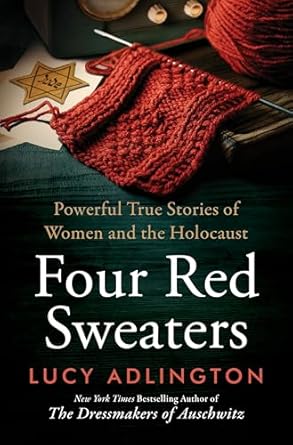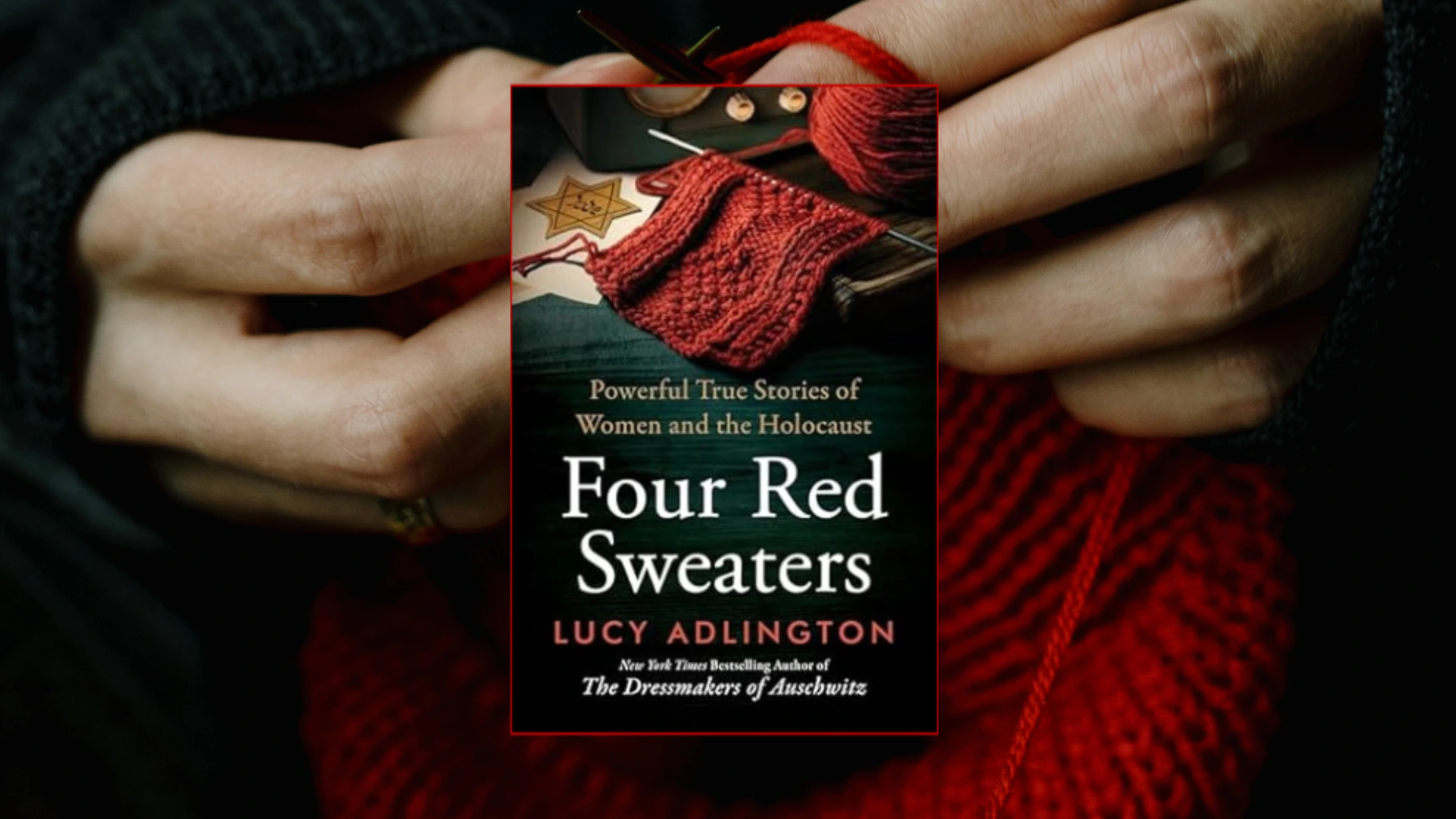Four Red Sweaters by Lucy Adlington
British clothes historian and novelist Lucy Adlington has written numerous fiction and non-fiction books with an emphasis on the roles of women in WWII including the New York Times best-seller The Dressmakers of Auschwitz.
She is also the co-owner of History Wardrobe, an events company presenting a variety of programs about costumes worn throughout history. Her undergraduate degree from Cambridge University in English Literature was followed by a master’s degree in Medieval Studies at the University of York. The obsession with costumes and vintage clothing began at the age of nine when she read The Costume Cavalcade filled with images of 3000 years of fashion history. Lucy has stated, “The glitz and glamour of historical fashion is great fun.
However, I’m more interested in so-called ‘ordinary’ garments. Clothes hold memories and connect us to the past in a deeply meaningful way.” Her current, must-read biographical work is Four Red Sweaters, subtitled Powerful True Stories of Women and the Holocaust. It is illustrated with over two dozen black and white images.
Red Wool, Real Women
Four Red Sweaters links four strangers who never met through the common ground of their ordinary wool sweaters or woolly jumpers as they are called in Great Britain and relates their deeply personal Holocaust experiences. The girls ranged in age from nine to nineteen at the beginning of the book and not all survived the Holocaust.
They were Jock Heidenstein, Anita Lasker, Chana Zumerkorn and Regina Feldman who each possessed a red sweater that played a surprisingly significant role in their lives. Their individual stories of strength, resilience and determination during this dark period in history is a reminder of the horror of Hitler’s resolve to eliminate Europe’s Jewish population and more significantly portray a celebration of love, friendship, courage, and the tenacity to endure.
The book opens in a dimly lit, hushed gallery of the Imperial War Museum in London wherein a history of the Holocaust includes an exhibition of clothing seized from Jewish prisoners upon their arrival in the various concentration camps. There are piles of all sorts of clothing from mundane everyday wear to fine furs and evening attire as well as the thin blue/gray striped prison garb, along with the mandated yellow stars visibly affixed to all outerwear. Stolen plunder from lives taken.
Among the many drab items is a faded, red angora sweater riddled with moth holes that survivor Anita Lasker-Wallfisch partially credits with saving her life in Auschwitz-Birkenau. She courageously stole it from a pile in “Kanada”, one of the Nazi sorting and storage houses. Had this act been noticed, she would likely have been instantly shot. She was the cellist in the Women’s Orchestra of Auschwitz for a year before being transferred to Bergen-Belsen concentration camp and wore this contraband sweater under her band uniform daily. These trained musicians were primarily amateurs which included some elite professionals like Anita Lasker who performed when trains arrived loaded with prisoners serving to calm them as the ‘selection’ process began. They played mornings and evenings at the gates as prisoners were marched out and back from job sites.
They were also often required to play for the camp Kommandant’s parties and social events. In between, they rehearsed 7-10 hours daily under the direction of Alma Rosé, previously a professional violinist and conductor of a small orchestra in Vienna and a niece of Gustav Mahler, who died in April, 1944. Alma was rigorous in her discipline and determination to have them perform as professionals instilling esprit de corps; a sense of purpose and hope. The small orchestra did receive slightly better housing, food and a warmer uniform but ultimately each member was acutely aware they were expendable.
Threads of Memory
Twelve-year-old Jochewet “Jock” Heidenstein and her sisters Rita and Gisela, later called Stella, had been gifted identical red sweaters purchased from a department store in the winter of 1938 which they wore while skating on the frozen lake at Wannsee outside of Berlin. These three girls were fortunate their parents realized that almost anywhere other than Germany would be safer for their children. One by one, they were able to obtain a place on the Kindertransport and were taken to safety in England.
They remained separated and were moved about until the war’s end. Stella received the best accommodations and better semblance of a real home than her sisters as she remained in one household for the duration of the war. Jock wore her talisman red sweater until it was completely stretched out with her maturing size but kept it as a memento of her beloved parents and a stark reminder of these harrowing times and relatives lost. It is now on display at the Imperial War Museum in their Kindertransport memorial collection.
Another red sweater is housed in the archives of Yad Vashem in Israel at the World Remembrance Center. It had been knitted by nineteen-year-old Chana Zumerkorn who lived with her family in Lodz, Poland before they were forced into the ghetto. Chana worked in a knitting factory making sweaters, scarves, gloves and socks for the Nazi military. Her brother Josef was desperate to escape and make his way out of Poland into Russia but Chana chose to remain behind with their parents. As a parting gift, she pulled her precious warm garment over her head and gave it to Josef.
The thick warm wool helped save his life during the harsh winters. He held onto it along with the precious memories of his beloved family. After 72 years he donated it to Yad Vashem for a permanent exhibition called “Gathering the Fragments” that includes photographs, documents and deeply personal memorabilia of those killed in the Holocaust.
Knitting to Survive
Sewing and knitting along with fine embroidery were typical skills girls were taught by their mothers, aunts and grandmothers in this time before so much was machine made and purchased in shops. Regina Feldman was an expert knitter, a skill which would save her life. When she and her parents were forced from their comfortable home in Poland, they were initially put to work digging ditches. Later, orders were received for them to join other Jews from their area, and were transported by horse drawn carts to Sobibor.
As Strauss waltzes were played over loudspeakers, an SS officer ordered the women arriving who could knit to step forward. Her mother Golda gave her a shove causing her to join eleven other girls. It was the last time she saw her family or anyone else in that transport. The twelve knitters did receive some special treatment: warmer clothing, additional rations and real showers for cleanliness while working with the wool yarns. However, they were each required to consistently produce one long army sock daily; a task that would ordinarily take a week or more to knit.
They were often “commissioned” to make special garments for the higher-ranking SS officers or the camp Kommandant’s family. Regina was tasked with making a large sized burgundy-red wool sweater for an unnamed officer. She never saw him nor the sweater again but it was one of the Four Red Sweaters.This exceptional fine work of non-fiction expands on these brief excerpts allowing the reader to experience more fully the traumatic conditions endured by these women during WWII, the Holocaust and beyond, often by quoting their own words.
The Rabbits, the Wool, the Irony
One surprising detail that author Lucy Adlingtonuncovered in her extensive research is that SS Chief Heinrich Himmler, one of the main architects of the Nazi’s “Final Solution”, was a great admirer of purebred angora rabbits. These domesticated rabbits have been bred for centuries for the high quality of their soft and silky fur which grows rapidly, about an inch per month. Thus, a large rabbit could produce as much as four pounds of luxurious, nearly hypo-allergenic wool per year.
Himmler operated large angora rabbit farms at both Auschwitz and Dachau Concentration Camps. 3000 rabbits kept indoors in commodious hutches in climate controlled conditions were fed an optimal diet and groomed regularly to comb and gather the dense fur which was then shipped for sale and processing. It required 300 prisoners to tend to these pampered money makers.
Lucy Adlington has included several pages of footnotes citing sources as well as an extensive bibliography. Cellist Anita Lasker-Wallfisch is the best known of the four subjects of Four Red Sweaters: Powerful True Stories of Women and the Holocaust as she has written her own memoir and been the subject of numerous articles and books as well as documentary and feature films.
Four Sweaters, Countless Lives
This reviewer fully agrees with her statement that “every individual story deserves to be told.” As history is being forgotten, not taught or presented with minimization or outright omission of the Holocaust, it is crucial to share their deeply personal remembrances to put faces on the horror in recognition the murdered were living, breathing human beings and not merely statistics.
To put it into context, imagine your friends and families disappearing forever, sometimes individually or together as a group. Six million Jews were systematically murdered during the Holocaust which, for example, is far greater than the entire population of Kentucky, this reviewer’s home state. Several million non-Jews were also killed including prisoners-of-war, political dissenters, gypsies, homosexuals and the mentally and physically infirm. Lucy Adlington has expertly knit together the fragmented lives of four women who represent but a tiny fraction of this enormous human tragedy.
About Lucy Adlington:
 With more than twenty years of experience in social history, Lucy is fascinated by the stories historical clothes tell about those who made, sold and wore them. She shares her insights through writing both non-fiction and fiction, as well as leading clothes-in-context events and presentations across the world.
With more than twenty years of experience in social history, Lucy is fascinated by the stories historical clothes tell about those who made, sold and wore them. She shares her insights through writing both non-fiction and fiction, as well as leading clothes-in-context events and presentations across the world.
Lucy loves reading and writing on the sofa. She is also on a quest to add to her collection of antique and vintage clothing. You will often find her exploring car boot sales, flea markets and vintage fairs looking for historical treasures.
Lucy lives on a working farm in Yorkshire with a patient farmer and a herd of rather fabulous cats.
Buy this Book!
Amazon




